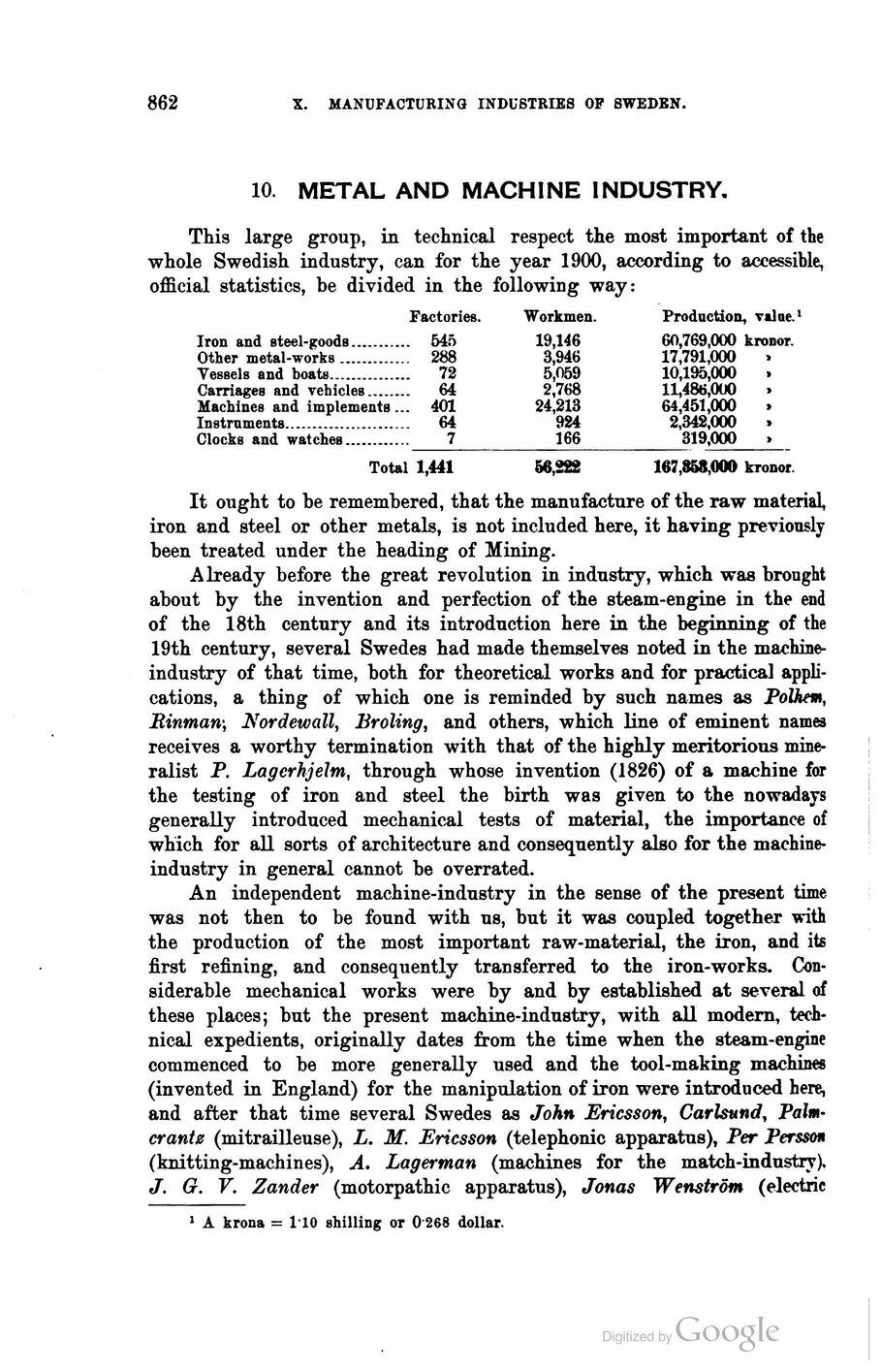
Full resolution (JPEG) - On this page / på denna sida - Second part - X. Manufacturing Industries. By Å. G. Ekstrand, Ph. D., Chief Engineer, Control Office of the Department of Finance - 10. Metal and Machine Industry, by Lector U. R. Ekstrand, Ph. D., Chalmers' Polytechnical College, Gothenburg

<< prev. page << föreg. sida << >> nästa sida >> next page >>
Below is the raw OCR text
from the above scanned image.
Do you see an error? Proofread the page now!
Här nedan syns maskintolkade texten från faksimilbilden ovan.
Ser du något fel? Korrekturläs sidan nu!
This page has never been proofread. / Denna sida har aldrig korrekturlästs.
862
x. manufacturing industries of sweden.
10. METAL AND MACHINE INDUSTRY.
This large group, in technical respect the most important of the
whole Swedish industry, can for the year 1900, according to accessible,
official statistics, be divided in the following way:
Factories. Workmen. Production, value.
Iron and steel-goods......... .. 545 19,146 60,769,000 kronor.
Other metal-works........... .. 288 3,946 17,791,000 »
Vessels and boats............. .. 72 5,059 10,195,000 .
Carriages and vehicles...... 64 2,768 11,486,000
Machines and implements . .. 401 24,213 64,451,000 >
Instruments..................... 64 924 2,342,000 .
Clocks and watches.......... 7 166 319,000 »
Total 1,441 56,222 167,868,000 kronor.
It ought to be remembered, that the manufacture of the raw material,
iron and steel or other metals, is not included here, it having previously
been treated under the heading of Mining.
Already before the great revolution in industry, which was brought
about by the invention and perfection of the steam-engine in the end
of the 18th century and its introduction here in the beginning of the
19th century, several Swedes had made themselves noted in the
machine-industry of that time, both for theoretical works and for practical
applications, a thing of which one is reminded by such names as Polhm,
Rinman-, Nordewall, Broling, and others, which line of eminent names
receives a worthy termination with that of the highly meritorious
mine-ralist P. Lagerhjelm, through whose invention (1826) of a machine for
the testing of iron and steel the birth was given to the nowadays
generally introduced mechanical tests of material, the importance of
which for all sorts of architecture and consequently also for the
machine-industry in general cannot be overrated.
An independent machine-industry in the sense of the present time
was not then to be found with us, but it was coupled together with
the production of the most important raw-material, the iron, and its
first refining, and consequently transferred to the iron-works.
Considerable mechanical works were by and by established at several of
these places; but the present machine-industry, with all modern,
technical expedients, originally dates from the time when the steam-engine
commenced to be more generally used and the tool-making machines
(invented in England) for the manipulation of iron were introduced here,
and after that time several Swedes as John Ericsson, Carlsund,
Palm-crantz (mitrailleuse), L. M. Ericsson (telephonic apparatus), Per Persson
(knitting-machines), A. Lagerman (machines for the match-industry).
J. G. V. Zander (motorpathic apparatus), Jonas Wenström (electric
1 A krona = 110 shilling or 0 268 dollar.
<< prev. page << föreg. sida << >> nästa sida >> next page >>